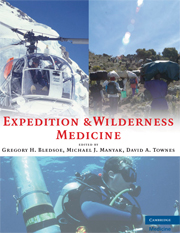Book contents
- Frontmatter
- Contents
- Contributors
- Foreword
- Preface
- Acknowledgments
- PART I EXPEDITION PLANNING
- 1 The Expedition Physician
- 2 Assessing Expedition Medical Needs
- 3 Expedition Medical Kit
- 4 Immunizations
- 5 Legal Considerations during Expedition Planning
- 6 Travel Safety
- 7 Nutritional Support for Expeditions
- 8 Water Treatment
- 9 Special Considerations
- 10 Communications Planning for the Expedition Medical Officer
- 11 Minimizing Risk on an Expedition
- 12 The Expedition Returns
- PART II EXPEDITIONS IN UNIQUE ENVIRONMENTS
- PART III ILLNESS AND INJURIES ON EXPEDITIONS
- APPENDIX The Expedition Medical Kit
- Index
2 - Assessing Expedition Medical Needs
from PART I - EXPEDITION PLANNING
Published online by Cambridge University Press: 05 March 2013
- Frontmatter
- Contents
- Contributors
- Foreword
- Preface
- Acknowledgments
- PART I EXPEDITION PLANNING
- 1 The Expedition Physician
- 2 Assessing Expedition Medical Needs
- 3 Expedition Medical Kit
- 4 Immunizations
- 5 Legal Considerations during Expedition Planning
- 6 Travel Safety
- 7 Nutritional Support for Expeditions
- 8 Water Treatment
- 9 Special Considerations
- 10 Communications Planning for the Expedition Medical Officer
- 11 Minimizing Risk on an Expedition
- 12 The Expedition Returns
- PART II EXPEDITIONS IN UNIQUE ENVIRONMENTS
- PART III ILLNESS AND INJURIES ON EXPEDITIONS
- APPENDIX The Expedition Medical Kit
- Index
Summary
Having to evacuate a trip member for any reason, be it physical or psychological, disrupts, even can cancel, an expedition and places other trip members and rescuers at possible personal risk. The pretrip history and physical evaluation is the first defense in preventing the subsequent evacuation. Maintaining vigilance as to the trip members' medical and mental status during the trip is the second step toward prevention of this expensive and risky event.
A caveat that cannot be ignored, due to legal reasons, is that if you are going to request medical information of a participant, make certain that you do something appropriate with the information. Protect the access of this information from persons who do not have a need to know these personal medical details. Review the history and physical information and make decisions concerning the applicant's appropriateness for the trip or otherwise ensure that you will be able to manage any problems that are identified during the course of the expedition.
Legal actions taken against trip organizers always start with the material provided by the client before the trip making sure that the risk was appropriately described, that the participant understood it, and that health and other protective services were as indicated in the pretrip materials (see Chapter 5). One aspect that will be scrutinized is the information obtained by the medical history and physical.
- Type
- Chapter
- Information
- Expedition and Wilderness Medicine , pp. 19 - 29Publisher: Cambridge University PressPrint publication year: 2008

